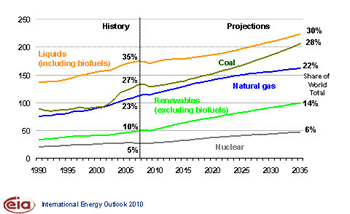 |
25 May 2010 – World marketed energy consumption grows 49 percent between 2007 and 2035, driven by economic growth in the developing nations of the world, according to the Reference case projection from the International Energy Outlook 2010 (IEO2010) released today by the U.S. Energy Information Administration (EIA). “Renewables are the fastest-growing source of world energy supply, but fossil fuels are still set to meet more than three-fourths of total energy needs in 2035 assuming current policies are unchanged,” said EIA Administrator Richard Newell.
The global economic recession that began in 2007 and continued into 2009 has had a profound impact on near-term prospects for world energy demand. Total marketed energy consumption contracted by 1.2 percent in 2008 and by an estimated 2.2 percent in 2009, as manufacturing and consumer demand for goods and services declined (Figure 1 ). In the Reference case, as the economic situation improves, most nations are expected to return to the economic growth rates that were projected prior to the downturn. Total world energy use in the Reference case rises 49 percent, from 495 quadrillion British thermal units (Btu) in 2007 to 739 quadrillion Btu in 2035.
China and India are among the nations least impacted by the global recession, and they will continue to lead the world’s economic and energy demand growth into the future. In 2007, China and India together accounted for about 20 percent of total world energy consumption. With strong economic growth in both countries over the projection period, their combined energy use more than doubles by 2035, when they account for 30 percent of world energy use in the IEO2010 Reference case. In contrast, the projected U.S. share of world energy consumption falls from 21 percent in 2007 to about 16 percent in 2035.
Average world oil prices increased strongly from 2003 to mid-July 2008, then declined sharply over the rest of 2008. In 2009, oil prices again trended upward and this trend continues in the Reference case, with prices rising to $108 per barrel by 2020 (in real 2008 dollars) and $133 per barrel by 2035. Total liquid fuels consumption projected for 2035 is 28 percent or 24.5 million barrels per day higher than the 2007 level of 86.1 million barrels per day. Conventional oil supplies from the Organization of the Petroleum Exporting Countries (OPEC) contribute 11.5 million barrels per day to the total increase in world liquid fuels production, and conventional supplies from non-OPEC countries add another 4.8 million barrels per day. World production of unconventional resources (including biofuels, oil sands, extra-heavy oil, coal-to-liquids, and gas-to-liquids), which totaled 3.4 million barrels per day in 2007, increases nearly fourfold to 12.9 million barrels per day in 2035.
 |
Other report highlights include:
- From 2007 to 2035, total world energy consumption rises by an average annual 1.4 percent in the IEO2010 Reference case. Strong economic growth among the non-OECD (Organisation for Economic Cooperation and Development) nations drives the increase. Non-OECD energy use increases by 2.2 percent per year; in the OECD countries energy use grows by only 0.5 percent per year.
- Petroleum and other liquid fuels remain the largest energy source worldwide through 2035, though projected higher oil prices erode their share of total energy use from 35 percent in 2007 to 30 percent in 2035.
- World natural gas consumption increases 1.3 percent per year, from 108 trillion cubic feet in 2007 to 156 trillion cubic feet in 2035. Tight gas, shale gas, and coalbed methane supplies increase substantially in the IEO2010 Reference case-especially from the United States, but also from Canada and China.
- In the absence of additional national policies and/or binding international agreements that would limit or reduce greenhouse gas emissions, world coal consumption is projected to increase from 132 quadrillion Btu in 2007 to 206 quadrillion Btu in 2035, at an average annual rate of 1.6 percent. China alone accounts for 78 percent of the total net increase in world coal use from 2007 to 2035.
- World net electricity generation increases by 87 percent, from 18.8 trillion kilowatthours in 2007 to 35.2 trillion kilowatthours in 2035. Renewables are the fastest growing source of new electricity generation, increasing by 3.0 percent per year in the Reference case; followed by coal-fired generation, which increases by 2.3 percent per year.
- In the IEO2010 Reference case, world industrial energy consumption grows 66 percent, from 184 quadrillion Btu in 2007 to 262 quadrillion Btu in 2035. The non-OECD economies account for about 95 percent of the world increase in industrial sector energy consumption in the Reference case.
- Almost 20 percent of the world’s total delivered energy is used for transportation, most of it in the form of liquid fuels. The transportation share of world total liquids consumption increases from 53 percent in 2007 to 61 percent in 2035 in the IEO2010 Reference case, accounting for 87 percent of the total increase in world liquids consumption.
- In the IEO2010 Reference case, energy-related carbon dioxide emissions rise from 29.7 billion metric tons in 2007 to 42.4 billion metric tons in 2035–an increase of 43 percent. Much of the increase in carbon dioxide emissions is projected to occur among the developing nations of the world, especially in Asia (Figure 2).
The IEO2010 Highlights can be found on EIA’s web site at:
http://www.eia.doe.gov/oiaf/ieo/index.html
CONTACT
EIA Program Contacts:
Linda Doman, +1 202 586 1041
John Conti, +1 202 586 2222
EIA Press Contact:
Jonathan Cogan, +1 202 586 8719











